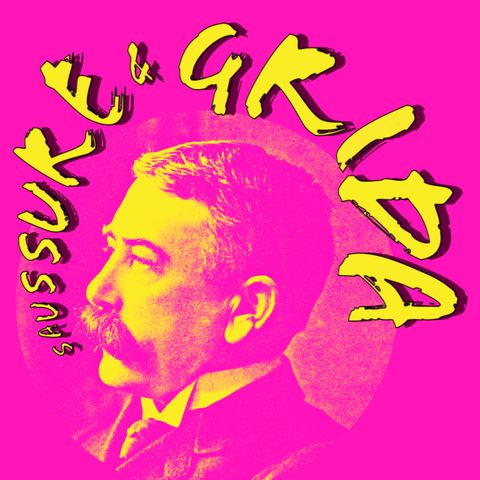16 APR 2024 · Questo episodio esplora l'ipotesi di Sapir-Whorf e la relatività linguistica, concentrandosi sul modo in cui le lingue possono influenzare la nostra percezione e comprensione del mondo. Oggi parliamo della storia del legame tra lingua e pensiero, esaminando come la struttura linguistica possa plasmare la nostra cognizione e la nostra relazione con la realtà circostante, e vediamo sopratutto cosa ci dicono i dati sperimentali.
Grafiche: Gianluca La Bruna
La sigla è stata prodotta da White Hot e fornita da https://freebeats.io
FONTI:
- Barsalou, L. (2008). Grounded cognition. Annual Review of Psychology, 59, 617–645.
- Belacchi, C., & Cubelli, R. (2012). Implicit knowledge of grammatical gender in preschool children. Journal of Psycholinguistic Research, 41:295–310.
- Berlin, B. & Kay, P. (1969). Basic color terms: Their universality and evolution. Berkeley: University of California Press.
- Boas, Franz (1889). On Alternating Sounds. American Anthropologist. 2(1):47–54.
- Boroditsky, L., & Schmidt, L.A. (2000). Sex, syntax, and semantics. In L.R. Gleitman & A.K. Joshi (Eds.), Proceedings of the Twenty-Second Annual Conference of the Cognitive Science Society (:42–46). Mahwah, NJ: Erlbaum.
- Brown, A., Lindsey, D.T., & Guckes, K.M. (2011). Color names, color categories, and color-cued visual search: Sometimes, color perception is not categorical. Journal of Vision, 11-12(2):1–21.
- Carroll, J.B. (Ed.) (1956). Language, thought, and reality: Selected writings of Benjamin Lee Whorf. Cambridge & Massachusetts: Technology Press of Massachusetts.
- Cichocki, P., & Kilarski, M. (2010). On "Eskimo Words for Snow": The life cycle of a linguistic misconception. Historiographia Linguistica, 37(3):341–377.
- Code, L. (1980). Language and knowledge. Word, 31(3):245-258.
- Darnell, R. (1990). Edward Sapir: linguist, anthropologist, humanist. University of California Press.
- Fortescue, M.D., Jacobson, S., & Kaplan, L. (Eds.) (2010). Comparative Eskimo Dictionary: With Aleut Cognates (2nd ed.). Alaska Native Language Center, University of Alaska Fairbanks.
- Gleitman, L., & Papafragou, A. (2013). Relations between language and thought. In D. Reisberg (Ed.), The Oxford handbook of cognitive psychology (:504–523). New York, NY: Oxford University Press.
- Humboldt von, W.C. (1836)[1988]. On Language: The Diversity of Human Language Structure and its influence on the Mental Development of Mankind. Cambridge, UK: Cambridge University Press.
- Kay, P., & Regier, T. (2006). Language, thought and color: recent developments. Trends in cognitive sciences, 10(2):51-54.
- Krupnik, I., & Müller-Wille, L. (2010). Franz Boas and Inuktitut Terminology for Ice and Snow: From the Emergence of the Field to the "Great Eskimo Vocabulary Hoax". In I. Krupnik, C. Aporta, S. Gearheard, & G. Laidler (Eds.) SIKU: Knowing Our Ice (:377-400). Dordrecht, NL: Springer Netherlands.
- Kurinski, E., Jambor, E., & Sera, M.D. (2016). Spanish grammatical gender: its effects on categorization in native Hungarian speakers. International Journal of Bilingualism, 20:76–93.
- Lenneberg, E., & Roberts, J. (1953). The denotation of color terms. Paper presented to the Linguistic Society of America, Bloomington.
- Matallo, H.J. (2023). Relativistic Language and the Natural Philosophy Big-Bang. Manuscript. PhilArchive.org
- Phillips, W., & Boroditsky, L. (2003). Can quirks of grammar affect the way you think? Grammatical gender and object concepts. Paper presented at the 25th Annual Meeting of the Cognitive Science Society, Boston, MA.
- Pinker, S. (1994). The Language Instinct. New York: HarperCollins.
- Platone, Fedro (2012). P. Pucci, & B.Centrone (Eds.), Roma- Bari: Laterza.
- Pourcel S. ( 2002). Investigating linguistic relativity: A research methodology. Durham Working Papers in Linguistics, 8:125-38.
- Pulvermuller, F. (1999). Words in the brain's language. Behavioral and Brain Sciences, 22:253–279.
- Roberson, D., Pak, H., & Hanley, J. R. (2008). Categorical perception of colour in the left and right visual field is verbally mediated: Evidence from Korean. Cognition, 107:752–762.
- Sapir, E. (1924). The grammarian and his language. The American Mercury, (1):149–155.
- Sapir, E. (1929). A study in phonetic symbolism. Journal of Experimental Psychology, 12(3), 225–239
- Sapir, E. (1933). La réalité psychologique des phonèmes. Journal de Psychologie Normale et Pathologique, 30:247–265.
- Sato, S., & Athanasopoulos, P. (2018). Grammatical gender affects gender perception: Evidence for the structural-feedback hypothesis. Cognition, 176:220–231.
- Scovel, T. (1991). Why languages do not shape cognition: Psycho- and neurolinguistic evidence. JALT (Japan Association for Language Teaching) Journal, 13(1):43-56.
- Taylor, I. (1976). Introduction to psycholinguistics. New York: Holt, Rinehart and Winston.
- Thierry G. (2016). Neurolinguistic Relativity: How Language Flexes Human Perception and Cognition. Language learning, 66(3):690–713.
- Trabant, J. (2017) Wilhelm von Humboldt linguista. In: A. Carrano, E. Massimilla, & F. Tessitore (Eds.) Wilhelm von Humboldt, duecentocinquant’anni dopo. Incontri e confronti (:1-21). Napoli: Liguori.


